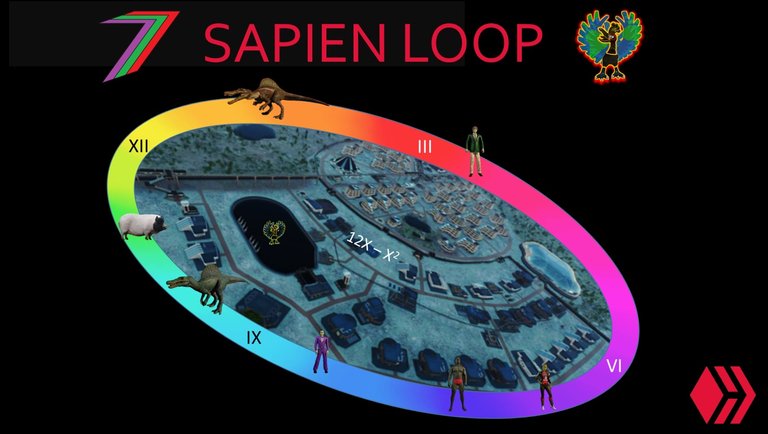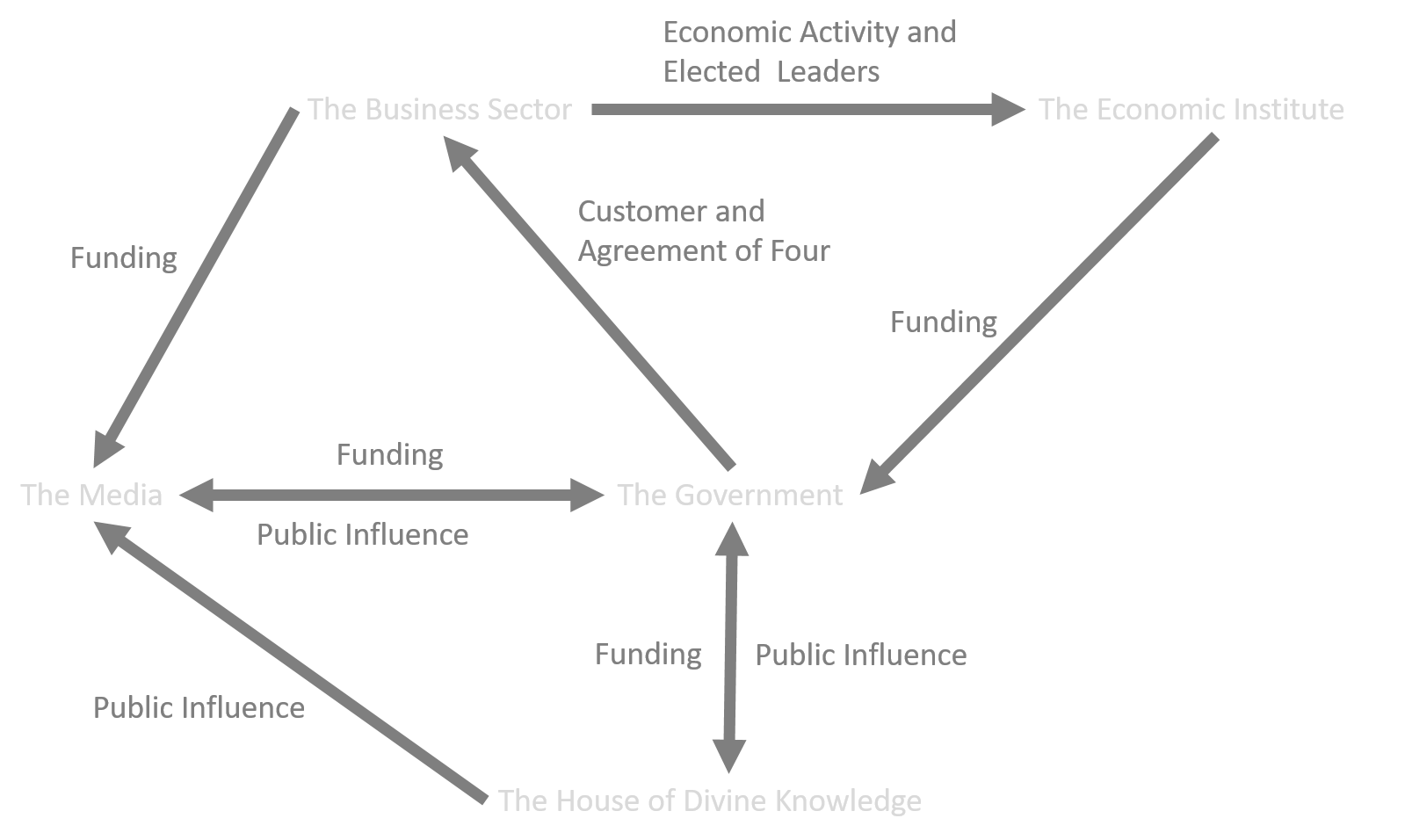
Chapter 72: Maintaining Control

Despite having smaller populations than the Sapiens, the Linap wanted to retain control of Sapey. They needed to do this without the Sapiens knowing. A group of senior Linap devised a societal structure they believed would enable the Linap to retain control while creating the impression that the Sapiens were in charge. For this to work, Sapey needed to look and feel like a utopia for Sapiens. It needed to be so good that it could only ever have been designed by Sapiens for Sapiens. For this to be possible, several steps were required.
Step 1: Create a Power Structure of Integrated and Dependent Systems
A power structure needed to be created. This power structure needed to protect the Linap from the Sapiens as well as from themselves. The Linap were often power-hungry and greedy. Their desire for power and wealth could expose them and the whole Linap species to the Sapiens. The power structure needed to prevent that from occurring.
The Linap had an existing societal structure in place. They had district leaders, various businesses, and the House of Divine Knowledge. These groups operated mostly independently but were cohesive with each other. These systems would not be sufficient to maintain control over the Sapiens. They needed to become considerably more integrated.
The power structure was to be overhauled. The three existing systems would be replaced with five. These five systems would work closely together, holding each other to account to maintain balance and to keep power from anyone outside of these systems.
System 1 was the Government. They needed to play the role of providers. They had the responsibility to ensure that all Sapiens had their basic needs addressed. They needed to be seen as benevolent leaders. They would be responsible for making choices that were for the benefit of Sapiens. There would be a trade-off for freedom, but the arguments for security, welfare, and the greater good would always win. They believed that if they could keep the Sapiens content, they would face minimal resistance.
The Linap wanted the Sapiens to believe that any form of rebellion would jeopardise their current high quality of life. If the system collapsed, all of society would collapse with it. They wanted the Sapiens to believe that no alternative system could possibly match the system that was already in place. The House of Divine Knowledge reinforced such fears.
The Government needed to be representative of Sapiens, and the representatives needed to be chosen by the Sapiens. Therefore, elections were necessary. Some Sapiens needed to reach high levels in Government but never to the extent that they could ever form even close to a majority.
System 2 was the Business Sector. They needed to play the role of producers and motivators. The Business Sector needed to be responsible for producing almost everything. This was to take the power of production and ownership of resources away from the Government; hence reducing their power.
To prevent the Business Sector from becoming too powerful, production needed to be spread across many different businesses; hence, the existence of the Agreement of Four. Businesses offered Sapiens employment, which enabled them to earn ‘privileges’. These ‘privileges’ were designed to incentivise Sapiens to work. In addition to ‘privileges’, work also offered purpose and reduced boredom, which were not intended to be addressed by ‘rights’.
The Business Sector ran the education and childcare systems. They played a role in brainwashing young Sapiens to support the systems that were in place, as well as motivated them to enforce these systems.
The majority of Linap were business owners. The systems were designed to continuously increase the wealth of businesses (i.e. the Linap). Almost all tokens would eventually end up being held by businesses. The Government paid newly created tokens to the Business Sector. All tokens paid as ‘privileges’, by businesses and Government Departments, would be exchanged for goods and services that were produced by the Business Sector.
Taxes paid by businesses to the Government would be paid back to the Business Sector in exchange for the provision of ‘rights’. Business activity and profits would determine which businesses would acquire the most wealth. The Agreement of Four was intended to enable all businesses to accumulate some wealth. Sapiens could not accumulate wealth as their tokens expired. If they wanted to continue to receive ‘privileges’ they must continue working.
System 3 was the Economic Institute. They needed to keep the economic system running. They enabled the Government to finance all the ‘rights’ they had committed to providing the Sapien citizens.
The Government needed something they could exchange with the businesses so that they would produce what they wanted. The answer was a recognised medium of exchange that could be easily produced. Tokens were originally made out of metal. This was not ideal, as they needed to be manufactured and could be hoarded outside of the systems. Carvaress Company, the largest business in the technology industry, invented digital programmable tokens. These tokens solved the problem of acquiring resources for currency as well as the hoarding of tokens by Sapiens. In exchange for this remarkable invention, Carvaress Company owners were given a very large payment in these newly created tokens. To a certain extent, this enabled them to have more monopoly power than desired but did not violate the Agreement of Four.
The Government was greatly dependent on the Economic Institute to issue them tokens. However, the Economic Institute was bound by an immutable law not to become involved in politics beyond arbiters under certain and limited circumstances. Their authority to issue tokens was linked to levels of economic activity, which were determined by the Business Sector. This was enabled by payments from the Government and expenditure from Sapiens. The Government, the Business Sector, and the Economic Institute were connected by a loop of control that was intended to prevent any of them from becoming too powerful.
System 4 was the media. The media can be considered an industry in the Business Sector but they are also a little different based on the role they serve. The media provided Sapiens with information about what was happening in their region and Sapia as a whole. They were responsible for presenting information that served the interests of the other systems (i.e. propaganda). The Business Sector financed the media through advertising their products, and the Government directly funded them to produce and present special programmes. What they presented could be swayed by whoever funded them.
The House of Divine Knowledge did not fund the media, but they could influence what channels Sapiens watched. Losing viewers would result in losing funding, as the Business Sector would pay less for advertisements if they were viewed by fewer Sapiens.
The media were also responsible for providing entertainment. Enjoyable entertainment programmes attracted more viewers, thus leading to more revenue. The Business Sector, the Government, and the House of Divine Knowledge could use entertainment to reinforce their ideology, values, and desired motivations.
The media determined which groups they wished to please. Therefore, they were in a position to play them off against each other. Media employees became the face of the presentation of entertainment and information. This enabled them to earn above-average rewards and ‘privileges’.
System 5 was the House of Divine Knowledge. The House of Divine Knowledge provided life-long learning to all Sapiens. It guided their core values and beliefs. These values revolved around helping each other and respecting all forms of authority. This was to create a culture of docility and obedience. The theologists and philosophers also described a chaotic and brutal world that existed before the modern society. This was to create fear of change as well as fear of both Sapiods and Sapes.
The House of Divine Knowledge was able to sway Sapiens political views through its teachings. Therefore, the governors needed to address the needs of this institution, or they could lose political office.
The House of Divine Knowledge, through their teachings, was not able to turn Sapiens opinions as quickly as the media, but their impact lasted much longer. They established a way of thinking and living that was much stronger than inciting a reaction to particular news stories. Many Sapiens became devoutly loyal to this institution.
Step 2: Isolation
Sapiens lived in mostly self-sufficient regions that had limited capacity and access to other regions. This had been done to restrict movement and isolate regions from each other. Each region had limited knowledge of what was happening in other regions. For small regions, transport was restricted to just one train in and out, and from a single location.
The media did not reveal much information about other regions unless motivated to do so. Communication between regions was limited. High walls, preventing alternative entry and exit points, surrounded each region. The high walls were justified to protect Sapiens from the wastelands, which they had been told were toxic. They were claimed to prevent the dense toxic air and dust particles from entering the regions.
The wastelands did not occur naturally. They originally began as the area contaminated by the Linap when they fought back against the Sentray. This contamination only lasted a few generations. In later years, they were intentionally polluted with disintegrated waste as a means of separating the regions. The waste products temporarily rendered the ground infertile.
Over time, the toxicity depleted. To keep the land infertile, it had to be continuously polluted with chemical waste from mining and manufacturing as well as with garbage from the regions. Contrary to the message from the Government, the air in the wastelands was not dangerously contaminated. There was no life because of the extent of pollution to the land and the contamination of the water.
Areas of the wastelands were cleared to build new regions when populations increased. The regions were often built years before they were inhabited, as the contamination was claimed to take a long time to clear. The real reason for building uninhabited regions was to provide employment to Sapiens and acquire assets and resources that could be used to justify the creation of more tokens.
Some regions were not surrounded by the wastelands. Instead, they were surrounded by resource ranges or agriculture zones. The resource ranges were considered too dangerous for inappropriately trained Sapiens to enter. The agriculture zones were vast areas owned by agriculture businesses and worked on by Sapiods. The businesses considered accessing these areas to be trespassing. They claimed they were afraid that their crops and livestock would be stolen or killed.
The most common reason the Government claimed for forbidding access to areas outside the region was the Sapiods. They claimed they could become dangerous if not handled in an appropriate manner. Sapiens were falsely told that the largest Sapes were kept as livestock and were allowed to roam the agriculture zones. The walls prevented them from entering the regions, as they could be destructive, cause damage to the region’s buildings, facilities, and infrastructure, and even pose a threat to the sapiens.
The reasons provided for restricting access beyond the regions’ walls were nearly always related to the safety and wellbeing of Sapiens. Sapiens did not breach the walls to access these areas because they were afraid of the dangers that they were repeatedly told about.
Step 3: False History
The House of Divine Knowledge was the first system created by the Linap. For generations, it formed the core of Linap society. The House of Divine Knowledge was founded based on ancient scriptures believed by many of the philosophers to have been written by an ancient and intelligent civilisation. These scriptures warned about the collapse of civilisation and contained what the theologists believed to be valuable lessons on how to avoid the disasters that destroyed this ancient civilisation.
The author ‘D’ wrote the scripture that contained the most compelling and notable warnings. The manipulation of the Linap’s genetics was in grave breach of these warnings. The Linap’s current predicament was an indication that these scriptures should have been taken more seriously.
Over the years, the Linap added their own scripture. This scripture documented their struggles and successes as well as offered lessons for future generations. The theologists would read from these scriptures. The philosophers contributed further interpretations of them. Some of the more senior philosophers would add their own scripture based on current events of believed significance.
After the Sapiens were created, the House of Divine Knowledge could no longer refer to these scriptures. Sapiens could not be allowed to know the real history of Sapey, Sapia, or the origin of their own existence. Therefore, an alternative history needed to be created. The revised history could not be complete fiction. It needed to contain several half-truths that supported the visible evidence. Some scripture was doctored, while other scripture was destroyed or hidden.
The biggest and most significant revision of history was the origin story of the Sapiens. The history of the struggles between the Linap and Sentray was retold as the struggles between the Sapiens and Sapiods.
The Sapiods were described as vile creatures that destroyed and killed everything in their path. The Sapiens were no match for the size and strength of the Sapiods. This forced them to run and hide. The Sapiens could not stay anywhere for any length of time, as their hunters were always in close pursuit. The Sapiens had no home or security. Life was hard and cruel. Their populations began to dwindle as they often lost significant numbers with encounters with the Sapiods. The Sapiens had almost lost all hope, as it appeared that they were going to be annihilated.
One day, everything changed. A god-like being (egotistically referred to in the doctored scripture as Linap) contacted the Sapien chief. He told the chief to take the remaining Sapiens to the fertile centre of Sapey. They were to surround themselves with high walls to keep the Sapiods out.
The land outside the walls would be cursed. Outside these walls, everything other than the Sapiods would die. The Sapiods would not die. Instead, they would be cursed for their violent and evil nature. They would lose their ability to feel anything. They would only exist to serve Sapiens.
After six moons, the curse was complete. The centre fertile lands grew and flourished. Sapey was now surrounded by a giant ocean. A new group of species known as the Sapes occupied the centre lands and the oceans. The Sapes were a gift to Sapey and the Sapiens. Sapiens were permitted to feast on them as they represented the new fruit of the land. These new species had no consciousness or spirit; therefore, they could be killed with no regret. Sapiens were not permitted to use the centre lands as their main place of residence. They could only stay there for the purpose of harvesting food.
The land outside the fertile centre remained cursed as a reminder that evil, violence, and greed were not tolerated. Linap instructed the Sapiens to build their civilisation on these cursed lands. Their civilisation would be built within giant walls. Eventually, the area within the walls would be cleansed, and Sapiens would live inside this walled area.
These areas would be referred to as regions. In each region, there must be a House of Divine Knowledge. This institute would represent the word of Linap. Sapiens would live long, fulfilling lives as long as they obeyed what they were taught. The most fundamental rule was to show love and kindness towards each other. If the Sapiens behaved like the Sapiods, they would be cursed, and the walls would no longer protect them. Sapiens were only permitted to travel outside the walls in blessed vehicles and in accordance with the teachings of Linap.
The false Sapien origin story was told frequently. Every Sapien child above the age of three would have heard this story at least once. It was to emphasise to the young that obedience was a core value for receiving a good quality of life. The story also created fear and a disliking for the Sapiods. This was important, as the Linap did not want the Sapiens to spend any time with the Sapiods or for them to feel any sympathy for the way they were treated.
Step 4: Control the Young
The existing Sapien population was accepting of the current structures and systems in place, but opposition could come from the next generation of Sapiens. To reduce the chances of this occurring, the ideology and beliefs of the young needed to be shaped at an early age. This needed to be done without arousing suspicion from the adult Sapiens. It needed to be done in such a way that it appeared to be for the benefit of both the parents and the children.
At around the age of one year, childcare was provided as a ‘right’. During the adult’s working days, children under the age of five were looked after at the region’s childcare facility. They were returned to the family for the adults’ days off. Adults could choose to not work and take care of their own children themselves but were offered no additional support beyond their own personal ‘rights’.
Working to earn ‘privileges’ while receiving support from the childcare service would appear to be the more logical approach; hence, the approach most Sapiens would adopt. Since the other steps ensured the adults would trust the system, adult Sapiens gladly volunteered for their children to be taken care of by the childcare facilities.
Around the age of five, children would switch from childcare to school. Unlike childcare, school was compulsory as it was considered a ‘right’ for the child. Whereas childcare was offered as a ‘right’ to the parents. All ‘rights’ for children were compulsory, as they were not considered mature enough to make their own informed decisions.
Children legally became adults at the age of seventeen. Children needed to attend school for at least one thousand hours a year. They needed to meet the syllabus requirements for their respective year of schooling. School was compulsory for twelve years. Additional training or revisiting of the previous curriculum was permitted and considered for another four years. This could be pursued at any time during adulthood.
Schools were run by education businesses. Each region would have at least four schools that were run by different businesses. Parents had the right to choose any of the four schools for their child. Parents would rank the schools in order of preference. Some schools were more popular than others. Admission was based on early application and the parent’s relationship with the school. Children with parents who previously attended the school or did voluntary work for the school were prioritised over children with parents who had no links to the school.
The school syllabus was designed by each education business based on input from the Government, the region’s branch of the House of Divine Knowledge, and the school’s board of parent volunteers. The core elements of each syllabus were fundamentally the same, but the advanced courses differed slightly. Children that excelled in particular areas were given the option to switch to a school that had advanced courses that best matched their abilities.
Step 5: Dissent Management
Despite all the systems and actions that the Linap used to control, deceive, and satisfy the Sapiens. The Linap were fearful that some Sapiens would still challenge the status quo. Sapiens were part Linap. It was not in their nature to accept domination. Therefore, the Government established a secret branch to seek out any dissenters in the regions.
If they found dissenters, they would join them and attempt to lead them. They would reveal some truths that were mixed with some critical lies. They would present themselves in a defiant way that would expose the dissenters to the public. They would obtain a forum to present their views and the views of the dissenters.
The Linap system would enable them to do so. They would initially offer little resistance. Instead, they would let the Sapien public oppose them. They would only respond with action against the dissenters after considerable pressure from the Sapien public. This would prevent any dissent from gaining traction, and it would appear that it had been squashed in a democratic way.
Both Sapiens and Sapiods originated from genetically modified Sapes. Working Sapiods were sterilised to prevent the risk that their population could grow out of control. This also meant that Sapiod populations could only be sustained by isolating the non-sterilised Sapiods for breeding. Alternatively, they could continue genetic engineering to controllably expand the Sapiod populations.
The Carvaress Company had an alternative idea that would be easier than genetically creating more Sapiods and would solve another potential problem. Sapiens were a threat to the Linap because they had a significantly larger population and were physically stronger. The biggest threat were the Sapiens, who were prone to questioning the system (e.g. dissenters) or were more ambitious.
Those who questioned the system had the potential to spread dissension to the point that the systems could come under threat. The ambitious Sapiens mostly did not challenge the systems but posed a threat because they could control some aspects of them. The Linap did not want to risk too many Sapiens gaining too much influence.
Sapiens did not need to be modified to become Sapiods, or at least Sapiod-like. They just needed to be brain damaged to reduce intellect and aggression. They could be made physically stronger with excessive muscle and size-enhancing therapies. The Linap did not care about any side effects of these therapies, as they considered Sapiens a lesser species. Sapien dissenters were supposed to be taken away to be rehabilitated. This was rarely the case. Instead, they were experimented on and/or assessed to determine if they would be more suitable for further experimentation or if they would make good Sapiods.
Those selected to be converted to Sapiods were taken away to receive surgery and hormone therapy that would convert them into something that resembled a Sapiod. Ambitious Sapiens moved to the large regions to hold higher positions in Government or business. They became isolated from their families. This was an acknowledged price to pay for acquiring status and potential ownership in one of the hundred businesses. This provided the opportunity to replace some of these successful Sapiens. A suitable Linap would shapeshift to become identical to the Sapien that was intended to be replaced. The ambitious Sapien would undergo the necessary treatments that would convert them into a Sapiod-like creature.
Future of Social Media

Captain Hive is here

Remember to catch me on Spectrumecons, click link below.
